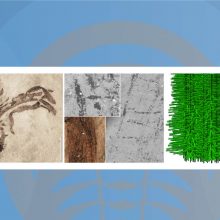
Photo from archive.org
Abstract. Four rare Pennsylvanian (Stark Shale: Pennsylvanian, Missourian [ =Kasimovian]) coleoids from Nebraska and Iowa, which are preserved as flattened partial phragmocones and body chambers associated with three-dimensionally fossilized ink… Click to show full abstract
Abstract. Four rare Pennsylvanian (Stark Shale: Pennsylvanian, Missourian [ =Kasimovian]) coleoids from Nebraska and Iowa, which are preserved as flattened partial phragmocones and body chambers associated with three-dimensionally fossilized ink sacs, are herein described as Pabianiconus starkensis new genus new species, Nebraskaconus whitei new genus new species, and Starkites compressus new genus new species. One specimen that is missing most of the phragmocone, is provisionally assigned to Donovaniconus. The fossils are assigned to the Coleoidea because of the presence of ink-filled sacs in the body chamber region of the conch. Additionally, eight fragmented and flattened phragmocones and body-chamber clusters with similar morphologies, including some with ink fragments and arm hooks, are assigned to the Coleoidea, but are not named because of their fragmentary condition. On most of the eight specimens, the shell material is associated with other unidentified finely macerated material, which suggests these fossils are probably either ejectoid masses or coprolites from coleoid predators and/or scavengers. However, the new genera named above appear to have been deposited as complete animals, based on the presence of the ink-filled sacs that are in the body chambers. With their body chamber and phragmocone morphologies, these rare coleoid taxa provide valuable information about conch variability within the Carboniferous evolutionary radiation of coleoids.
Journal Title: Journal of Paleontology
Year Published: 2018
Link to full text (if available)
Share on Social Media: Sign Up to like & get
recommendations!